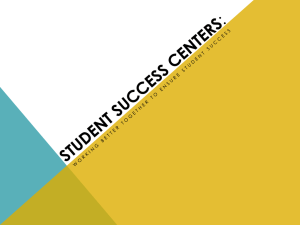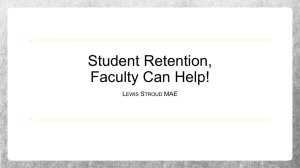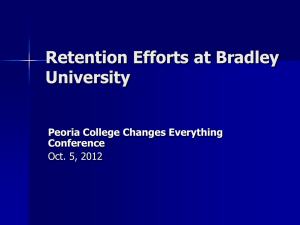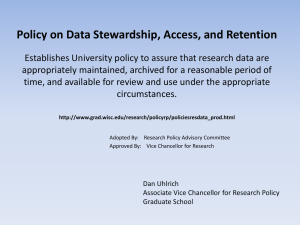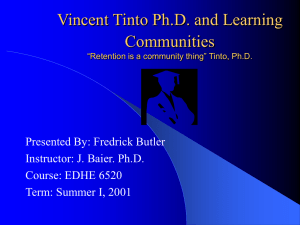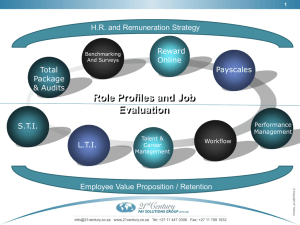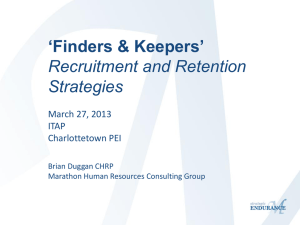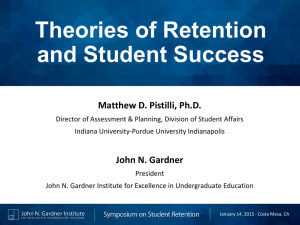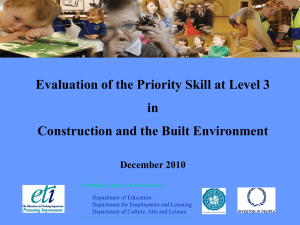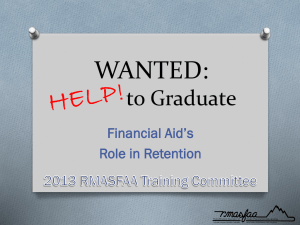Document
advertisement
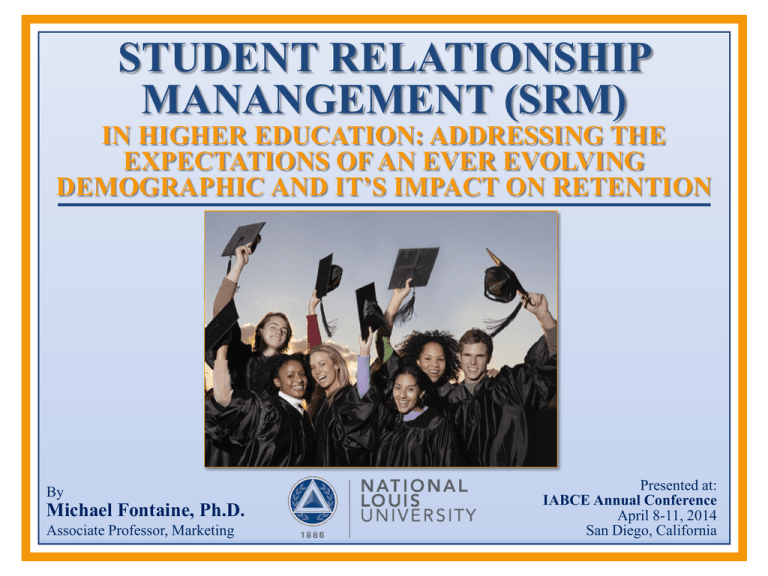
STUDENT RELATIONSHIP MANANGEMENT (SRM) IN HIGHER EDUCATION: ADDRESSING THE EXPECTATIONS OF AN EVER EVOLVING DEMOGRAPHIC AND IT’S IMPACT ON RETENTION By Michael Fontaine, Ph.D. Associate Professor, Marketing Presented at: IABCE Annual Conference April 8-11, 2014 San Diego, California THE QUESTION: • WHAT DOES STUDENT RELATIONSHIP MANAGEMENT MEAN TO YOU? THE PREMISE • Customer orientation has been underemphasized in colleges and universities compared to profit-oriented organizations. However, the increased turmoil in the higher education marketplace may force colleges and universities to utilize a more customer-oriented philosophy in delivering their services, and those who understand these principles will have a better chance of achieving their objectives more effectively (Kotler and Fox, 1995). • Even though one might hesitate to call students “customers” because of the studentteacher relationship, this still does not change the fact that without students, there would be no need for colleges. • Hence, the need to manage college enrollments from the point of initial student contact to the point of graduation has become increasingly important (Seymour, 1993) • For example, students who complain and are responded to immediately, even if the response is not favorable, can actually become more loyal than students who appear to be satisfied without complaints (Kotler and Fox 1995) • Traditionally, businesses have concentrated their marketing efforts on attracting new customers to maximize profits. Over the last few decades however, service-oriented businesses have shifted away from this traditional marketing strategy toward a relationshipmarketing approach that focuses on developing long-term relationships with existing customers (Barnes, 1994). • This approach assumes that retaining satisfied customers will ultimately prove more costeffective than continually spending marketing dollars on securing new customers (Barnes; Berry, 1995; Sines & Duckworth, 1994). • Some higher education scholars have suggested a relationship-marketing approach to enrollment management might similarly cut student recruitment costs and increase student retention ( Ackerman & Schibrowsky, 2007; Helgesen, 2008; Rowley, 2003; Trustrum & Wee, 2007. B. J. Shaver, (2012) Customer experience • Relationship–marketing theory places customer retention under the larger umbrella term of customer loyalty because repeatedly purchasing the services of a service provider is only one way for a customer to demonstrate loyalty. For example, a customer might also show their loyalty to the provider by recommending the service to others. • Understanding the issues of university student retention from a relationship-marketing perspective similarly involves placing the student retention within the larger framework of student loyalty. A student can demonstrate loyalty by continuing to enroll in classes at the university. They can also show their loyalty by recommending the university to others. The Studies of University Student Loyalty has shed light on the following questions: 1. How does undergraduate students’ satisfaction with their university experiences relate to their retention behavior? 2. How does undergraduate students’ satisfaction with their university experiences relate to their loyalty behavior? 3. What are undergraduate students’ expectations of their university experiences? 4. How does the fulfillment of undergraduate students; expectations of their university experiences relate to their retention behavior? 5. How does the fulfillment of undergraduate students’ expectations of their university experiences relate to their loyalty behavior? Earlier student retention studies in higher educational institutions have focused on academic ability as the predictor of retention. However, these studies reported that academic performance could only account for half of the variance in dropout rates (Pantages and Creedon, 1978). Also, a growing body of research suggests that the social adjustment of students may be an important factor in predicting persistence (Gerdes and Mallinckrodt, 1994, Mallincrodt, 1988). These studies argue that integration into the social environment is a crucial element in commitment to a particular academic institution (Spady, 1970; Tinto, 1975). • Tinto (1982) formulated a student integration theory of persistence or retention based on the relationships between students and institutions. He argued that retention involves two commitments on the part of the student. • The first commitment is the goal commitment to obtain a college degree. • The second is the decision to obtain that degree at a particular institution (institutional commitment). Overall, the combination of the student’s goal and institutional commitments affected retention at a particular institution. • Under this perspective, it is important to match the student’s motivation and academic ability and the institution’s ability to meet the student’s expectations. • Attracting students, processing their applications, and guiding admitted students through the enrollment process are extremely important activities. However, treating students as partners is crucial to optimize students’ experience from enrollment to graduation (Kotler and Fox 1995) In this process, a person-to person relationship between students and universities/colleges is of extreme importance for better planning and implementation. • Thus, we argue that faculty performance, advising staff performance and classes are three of the most important variables that influence students’ college experience and overall satisfaction. • It is also argued that satisfaction influences students’ intentions to stay at or leave the institution. • It is known that satisfaction level is determined by the difference between service performance as perceived by the customer and what the customer expects (Parasuraman et al., 1986). • According to Voss and Voss, 2000), given the distinguishing features of the higher education institutions, the value should be based on the long-term interest of students and society and institutional goals and commitments. • It is the quality of the experience and relationship that benefits both a higher education institution and its society. Thus, there is a symbiotic relation between the student, college or university, and society as a whole. PERCEIVED SERVICE QUALITY • In a study by Macothink Institute on the Impact of Service Quality on Students’ Satisfaction in Higher Education Institutes of Punjab, the service quality in the educational sector particularly in the higher educational institutions is the fundamental aspect of educational excellence. According to (Alridge and Rowley, 2001) when students perceive the institution’s quality and standardized learning environment facilitated with intellectual faculty, appropriate facilities of learning and infrastructure, their interest in their organization will explicitly be retained. • The students are motivated from the academic as well as the administrative efficiency of their institution. Spooreen, et. Al (2007) posited a view that the organizational harmony, teachers’ intellectual ability, professional develop, transparency in students’ evaluation, feedback and training are the important features that mentally develop the students. • According to Soutar and McNeil (1996) both academic and administrative issues of an institution are extremely important in determining the performance of students, development of organizational image and quality assurance. Elliot and Shin (2002) found that the highly significant variables in the model that appear to directly impact overall customer satisfaction with university performance are: VARIABLES 1. Excellence of instruction in major 2. Able to get desired classes 3. Knowledgeable advisor 4. Knowledgeable faculty 5. Overall quality of instruction 6. Tuition paid is a worthwhile investment 7. Approachable advisor 8. Safe and secure campus 9. Clear and reasonable requirements for major 10. Availability of advisor 11. Adequate computer labs 12. Fair and unbiased faculty 13. Access to information • The results of the Punjab study also showed that the cooperation, kindness of administrative staff and the responsiveness of the educational system play a vital role in retaining the students’ interest as the administration should be responsible in providing all the essentials and necessities required progressive learning environment. • The students seek the feelings of empathy, nobleness and kindness in their institute’s administrative staff. Therefore, the administration should be careful in training the employees in order to come up to the expectation of the students. • In addition to the learning environment there are certain other essential facilities which are also important for the students i.e. the well managed cafeteria, parking facilities, play grounds and other arrangements of physical and mental health e.g. clubs, gymnasiums etc. • Assuring all the facilities and quality of services with excellence and reliability, an institution can attract a lot of students by having its name in the leading educational institutions of learning. ACADEMIC INTEGRATION • Incongruence or incompatibility and isolation of the student can lead to dissatisfaction. The lack of social and academic integration is an important factor influencing attrition. Students who feel alienated by the institution, its faculty and staff, and other students are likely to leave the institution (Heverly, 1999; Keim, 1981; Pascarella, Smart & Ethington, 1986; Tinto, 1993). • The final category takes into account the external obligations and finances that can affect a student’s ability to complete their education (Tinto, 1993). Non-traditional students as well as traditional students face a greater number of external forces, which can derail their educational goals. More students have to work, have families and attend school part-time than in previous generations of students (Levine & Cureton, 1998). Even though many traditional students face these external issues, the hardest hit are the non-traditional adult students who become dissatisfied with the educational process and leave higher education altogether (Bean & Metzner, 1985; Grimes & Antworth, 1996; Kinnick & Ricks, 1993). SOME “BEST PRACTICES” • Following up on the success of a nationally recognized first-year experience program, William Jewell College in Missouri has launched a new sophomore experience program aimed at extending the assisted period of adjustment to academic and social components of college life. • “We have a nationally recognized first year experience program, but what we heard from our students was that once they weren’t first-year students anymore, they felt that they went from a situation in which they hot lots of attention to a situation in which they didn’t have that anymore but still wanted to remain connected to the college more intentionally”, says Rick Winslow, the college’s dean of student affairs. • William Jewell’s first year program was named a “National Program” to look for in the 2006 edition of the U.S. News and World Report “ America’s Best Colleges”. The first-year experience program was also one of the primary factors cited by Time magazine in naming William Jewel its liberal arts college of the year in 2001-02. • Jewell’s retention rates have risen from 72% to 86% since it instituted its orientation program in 1997. RESOURCE GUIDES HELP FIRST YEAR STUDENTS Recognizing that faculty members who teach first-year students play a crucial role in their students’ success, Illinois State University has developed its Resources Guide for Faculty teaching first-year students, a brief, online document intended to: • • • • Raise awareness of the importance of the first-year experience Inform faculty of support services available on campus Gives faculty a holistic understanding of the first-year experience and the important role they play Enhance the importance and prestige of teaching first-year students The guide, developed by members of the university council for first year experience includes: • • • • • An overview of the university’s participation in the foundation of excellence in the “First College Year Project: A timeline of first-year experience events and programs A first-year curriculum update Information about working with the millennial generation, including case studies Information about support services (arranged by topic) MEETING THE SPECIAL NEEDS OF ADULT STUDENTS Adult learners, long the stepchildren of colleges and universities, have nearly become the norm, and they spend billions of dollars each year on education. Have colleges and universities alienated this rich market pool? J. Hadfield (2003) According to J. Hadfield, (2003), there are only two circumstances under which we should consider an adult learner not retained. If a student transfers to another institution to complete the course of study begun at our institution, we have lost them. Death is the only other circumstance that should remove a student from our rolls permanently. All other students we should consider retained, even if it takes them fifteen years to reach an education goal. This recognition of a difference in the meaning of retention is critical to the decisions we make about marketing strategies. Students who have previously attended but are not currently enrolled create our richest market pool. What, then, is the solution to the problem of attracting and retaining adult learners? Although for many in academia, the word “customer” is almost an obscenity when referring to a student, customer satisfaction is the key to attracting and retaining adult students. “Customer” is exactly how adult learners think of themselves, and they hold our institutions of higher education accountable for providing paid-for results and educational experiences that make a difference in their lives. If you are asked, “Does your school deliver superior customer service?” can you answer unequivocally yes? If you cannot, you are missing the most effective way to differentiate your institution from competitors. If you can, you know the secret to attracting and retaining adult learners. You know how a school demonstrates customer service. Here are some tips: We Serve Our Customers When We Make Our School Their School Adult students may show up for evening and weekend classes and find darkened buildings whose only lighted area is the classroom for the course. The business, financial aid, academic advising, and other student support offices have been closed since five o’clock. Our behavior communicates the message that the older adults are not “real” students. We Serve Our Customers When We Ask Them What They Need to Learn Many years ago, Malcolm Knowles, the “father” of adult education, described the adult learner as “self-directing.” Unlike younger students, adults come to college with specific goals, expectations, and learning objectives for the time, energy, and money they will invest. We Serve Our Customers When We Ask Them What They Do Not Need to Learn Nontraditional students bring to our institutions learning from previous work and life experience and non-collegiatesponsored professional education that must be validated. It is a foolish waste of time to require students to complete courses they could teach. We Serve Our Customers When We Deliver What They Need When They Need It Excellence in customer service demands that we constantly scan the environment to identify changes in the job market, new and developing workplace skills, and emerging businesses and emerging businesses and industries. We Serve Our Customers When We Put Great Teachers in the Classroom People intrinsically are motivated to learn when they are given the right conditions and encouragement, and great teachers are the keys to learner motivation. We Serve Our Customers When We Deliver Meaningful Learning Experiences Nontraditional students are problem centered and life centered in their orientation to learning. They are not beginning their adult life; they are in the middle of it or, sometimes, near the end of it. This difference in time perspective produces a difference in the way they view learning. We Serve Our Customers When We Listen to Their Complaints, Questions, and Suggestions No one likes to listen to a complaint, but every complaint is an opportunity to improve. Complaints give us advanced warning about problems and an opportunity to take preventive action. Resolving the complaints of students has a significant effect on retention. We Serve Our Customers When We “Walk the Talk” Our actions and deeds always support our verbal commitment to superior customer service. We keep our promises, correct our mistakes, are proactive in solving problems, and work to exceed the expectations of our customers. We Serve Our Customers by Continuously Measuring Our Performance Customer service is a principle of best business practice, and so is measurement. We constantly measure the effectiveness of the processes we have in place to deliver that service. LET’S NOT FORGET ABOUT THE INTERNATIONAL STUDENTS According to R. Amash (2001), the education of International students has a long history in American higher education. Students from often times less developed countries come to the U.S. to acquire knowledge and skills that they can use to improve their home countries and to foster personal growth through cross-cultural learning and exchange. The Challenges: • Socialization and Integration Challenge • Housing and Living • Financial Challenges and Employment • English Language Competence THE INTERNATIONAL STUDENTS (CONT.) The relationship between student and institution must be a balance of performance, integration, adjustment, and the quality of service. Summary of the Needs, Challenges of International Students and Recommendations • • Developing a “Buddy System” for new international students • • • Redesigning the orientation sessions. • • • Financial assistance is needed for international students The development of strategies to improve communication between international students and American students Immigration assistance and services should be considered The establishment of a plan to help international students finding an employment opportunities on and off campus to gain work experience in their field and help them financially Promoting multi cultural clubs and activities Providing the international students with lists of all the religious and cultural clubs, organizations and other institutions as a support system for the students CONCLUSION • The use of relationship marketing in higher education will transform the way it does business. Relationship marketing techniques such as individualized attention and communication, and developing long-term relationships will change the way higher education thinks about its students. In the near future, the success of an institution of higher education will depend on treating different customers differently based on whether a particular individual is looking for a four-year socialization experience, personal enrichment and the satisfaction of curiosity, preparation for the current job she has or the next one she wants, or something else (Peppers & Rogers, 1998, p. 48).” • Ackerman and Schibrowsky (2007) believe the future of higher education is in building long term relationships with students. In their article, “A Business Marketing Strategy Applied to Student Retention: A Higher Education Initiative,” they coin the term Student Relationship Management (SRM) for those programs designed to build relationships with students to increase retention. They claim SRM is not just a retention tool, but an institutional philosophy based on a marketing concept which prompts university leaders to take a different view of the institution’s interactions with students. YEAH!! ENDS NOTES 1. Ackerman, R. and Schibrowsky, J. (2007). A Business Marketing Strategy Applied to Student Retention: A Higher Education Initiative. Journal of College Student Retention, 9(3), 307-336. 2. Alridge, S. & Rowley, J. (2001).Conducting a withdrawal survey. Quality in Higher Education, 7(1), 5563. 3. Amash, R. (2011), What can Higher Education learn from the Business World in terms of Customer Satisfaction? The Business Review, Cambridge, Vol. 19 Num.1, December 2, 2011. 4. Barnes, J. (1994). Close to the customer: But is it really a relationship? Journal of Marketing Management, 10, 561-570. 5. Berry, L. (1995). Relationship Marketing of Services – growing interests, emerging perspectives, Journal of the Academy of Marketing Science, 23(4), 236-245. 6. Campbell, J.M., et. al, and Levine and Cureton, (1998) & Heverly, (1999). The use of Relationship Marketing Techniques in Higher Education, ProQuest Dissertations & Thesis; 2002, ABI IFORM. 7. Campbell, J.M, et. al, Peppers and Rogers (1998) & Creedon (1978), The use of Relationship Marketing Techniques in Higher Education, ProQuest Dissertations & Thesis; 2002, ABI INFORM. 8. Elliot, K. & Shin, D. (2002). Student satisfaction: An alternative approach to assessing this important concept. Journal of Higher Education Policy and Management, 24, 197-209. 9. Gerdes, H. and Mallinckrodt, B. (1994), “Emotional, social and academic adjustments of college students: a longitudinal study of retention, Journal of Counseling and Development, Vol. 72, January/February, pp. 281-88. 10. Kotler, P. and Fox, K.F.A. (1995), Strategic Marketing for Educational Institutions, 2nd ed., Prentice-Hall, Englewood Cliffs, NJ. 11. Parasuraman, A. Zeithaml, V. and Berry, L. (1986) “SERVQUAL: a multiple-item scale for measuring customer expectations of service quality’, Report No. 86-108, Marketing Science Institute, Cambridge, MA. 12. Recruitment and Retention in Higher Ed. “The State of College Admission, 2006: Application numbers rebound, acceptance rates stay high”, July 2006, vol. 20, No. 7. 13. Soutar, G. & McNeil, M. (1996). Measuring service quality in a tertiary institution. Journal of Educational Administration, 34(1), 72-82. 14. Spooren, P., Mortelmans, D. & Denekens, J. (2007). Student evaluation of teaching quality in higher education: development of an instrument based on 10 Likert-scales. Assessment and Evaluation in Higher Education, 32, 667-679. 15. Tinto, V. (1993), Leaving College: Rethinking the Causes and Cures of Student Attrition, 2nd ed., University of Chicago Press, Chicago, IL. 16. Voss, G.B. and Voss, Z.G. (2000), "Strategic orientation and firm performance in an artistic environment", Journal of Marketing, Vol. 64, pp. 67-83.
